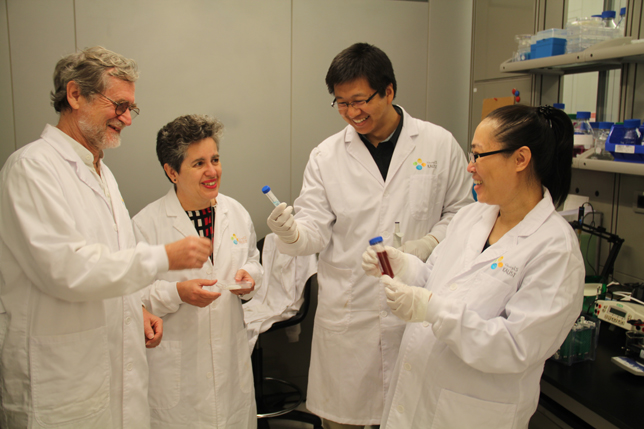A new perspective leads to discovery of simple self-assembly structure

Sometimes what it takes to discover something new is a team with a diversified vision….and a lot of patience. At least, this was the case with the latest biomimetic block copolymer particle research conducted by KAUST professors Dr. Klaus-Viktor Peinemann and Dr. Suzana Nunes, along with post-doctoral fellows Dr. Haizhou Yu and Dr. Xiaoyan Qiu.
"For me, the most interesting thing with this experiment, is that when most people reach a point in the results when they think this is not what is expected, they will stop. But Haizhou Yu and Xiaoyan Qui didn't stop. They are the type of people who will take the results and be curious enough to go forward and find the real beauty of it," said Dr. Suzana Nunes, Professor of Environmental Science and Engineering.
Using their combined experience with block copolymers and self-assembly, the research completed by the all-KAUST team of faculty and postdocs from two centers utilized what they knew to learn something they didn't. When the initial results were not as planned, they continued to explore to see what happened. Taking the chance on waiting was worth it. "They found a nice biomaterial application. Then investigated why this structure is that way and not in the way we expected it to produce," Nunes said.
Their results were published in Natures Communication in May (DOI 10.1038/ncomms5110). The paper explains how they found a simple way to fabricate microspheres through block copolymer self-assembly. The particles they found are able to act as pH-responsive gates and have a highly porous infrastructure, which allows them to have ultrahigh protein sorption capacity. It was the first time this simple strategy to fabricate micrometer-sized spheres with complexed porous order and gated nanopores by BCP self-assembly had been reported.
A WINNING DIVERSIFIED TEAM
For over a year, the team had been working on this block copolymer research with an interest in self-assembly. "We always want to develop structures which can do new types of polymer separations – separations that are difficult to do. This is our main goal," explained Dr. Klaus-Viktor Peinemann, Professor of Chemical and Biological Engineering.
With this particular project, they took a powder from a polymer and stirred in it different organic solvents. As they stirred it, the structures formed and changed over time. "In the end, we made quite interesting particles. We are trying to learn from nature and are using the principle of self-assembly like nature does," Peinemann said.
The particles the team found contained attributes that could be useful in biotechnology, medicine and catalysis applications. They were able to separate specific proteins by electro static interaction or by size. The particles were also able to absorb these proteins. "Another potential application for the particle is the control and release of certain proteins. For example, they may perhaps be loaded with a drug and injected into body and then slowly release the drug," Peinemann said.
But this discovery may have not occurred without the dynamics of the team involved. They say without their mix of expertise, they may not have immediately seen the potential in the initial structures – nor would they have realized how time would have changed the shape of the particles.
As members of KAUST's Advanced Membranes & Porous Materials Center and Water Desalination and Reuse Center, Peinemann has decades of experience in creating large-scale membranes, while Yu is experienced in block copolymers and Nunes' specialty is in membranes and polymer thermodynamics. But it was Xiaoyan Qiu's expertise in proteins and biology that gave them the breakthrough they needed.
"When I looked at the structure, I looked at it like chemistry. But because her background is in biology, she saw things differently. When she looked at it, she said it looked like biomaterials," said Yu.
Qiu's biology knowledge gave the chemistry and membrane team insight from a new perspective. She noted when looking at the pore size, that it might be suitable to separate something like proteins. And because the pores were so regular, they were not only able to separate proteins, but ones with almost equal molecule weight.
LOOKING TO NATURE FOR FUTURE MEMBRANE SOLUTIONS
Currently, many groups are looking what nature has and trying to mimic what it can do. Nunes says their case is unique as the structure is completely porous, with complex order and interconnected. It can absorb the protein similar to how it would work in nature. "It's the way many of our own organs work. We, ourselves, are in a way self- assembly. This is amazing to get this structure just by mixing without a planned specific design or probing. You have an order that is happening spontaneously," she said.
The team says they are trying to learn from these biological channels as they are much more effective than our artificial channels. This research was one of their ways to approach it, but other groups around the world are trying different things.
"We – and I mean the scientific groups around world - are in a state of development where we can afford to explore much more complex mechanisms of transport," said Nunes. "I think with all the knowledge we now have on membranes, it's time to go a step forward and mimic some of the special biological channels that allow for complex separation."
By Michelle A. Ponto, KAUST News

